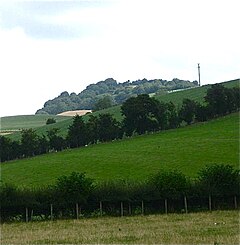Ffridd Faldwyn, Montgomery
| Ffridd Faldwyn, Montgomery | |
|---|---|

Fridd Faldwyn Iron Age Hillfort on the skyline, as viewed from Llandyssil
|
|
|
|
|
| OS grid reference | SO217969 |
| Coordinates | 52°34′N 3°10′W / 52.56°N 3.16°WCoordinates: 52°34′N 3°10′W / 52.56°N 3.16°W |
Ffridd Faldwyn is an Iron Age Hillfort in northern Powys, in the former county of Montgomeryshire, It is sited on a prominent hill west of Montgomery, close to Montgomery Castle, overlooking the River Severn. It is one of the largest hill-forts in Wales.
When Thomas Pennant visited Montgomery in 1776, he noted "On a hill, not far from the castle, is a stupendous British post. The approach is guarded by four great ditches, with two or three entrances towards the main work, with two or three fosses run across the hill, the end of which is sufficiently guarded by its steepness". The site was described and surveyed in June 1909, by the RCHMW. A detailed survey of the hillfort was published in 1932 by Dr Willoughby Gardner, and this led to excavations being carried out by B. H. St John O’Neil between 1937 and 1939,
These excavations by St John O'Neil, who was the Inspector of Ancient Monuments in Wales, were carried out to a high standard. Five sections were cut across the various ramparts and three area excavations were opened. This was following the most recent excavation practices developed by Mortimer Wheeler for his excavations at the hillfort at Maiden Castle in Dorset. O’Neill was able to define the earliest phase of the hillfort as smaller enclosure measuring 170 m by 80 m (1.2 hectares), with a gateway to the south, and defended with two rows of timber palisading. This enclosure stands on the highest area of the hill and contains a small mound which may have been a Bronze Age round barrow. Under the southern gate of this enclosure evidence for earlier Neolithic occupation was found. This enclosure was then modified by a box framed timber rampart, with an extension to the north-west and a barbican added to the south gateway. The inner area of the enclosure contained a number of rectangular "four-poster" structures, which are now interpreted as the supports for wooden framed granaries.
...
Wikipedia

